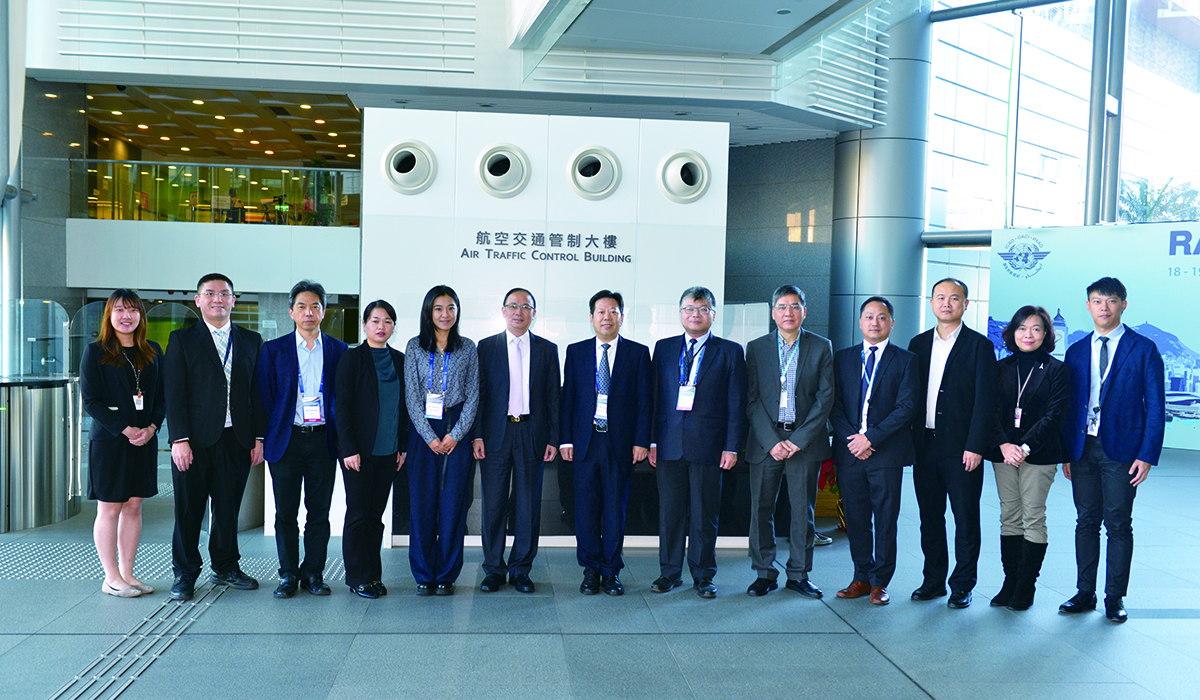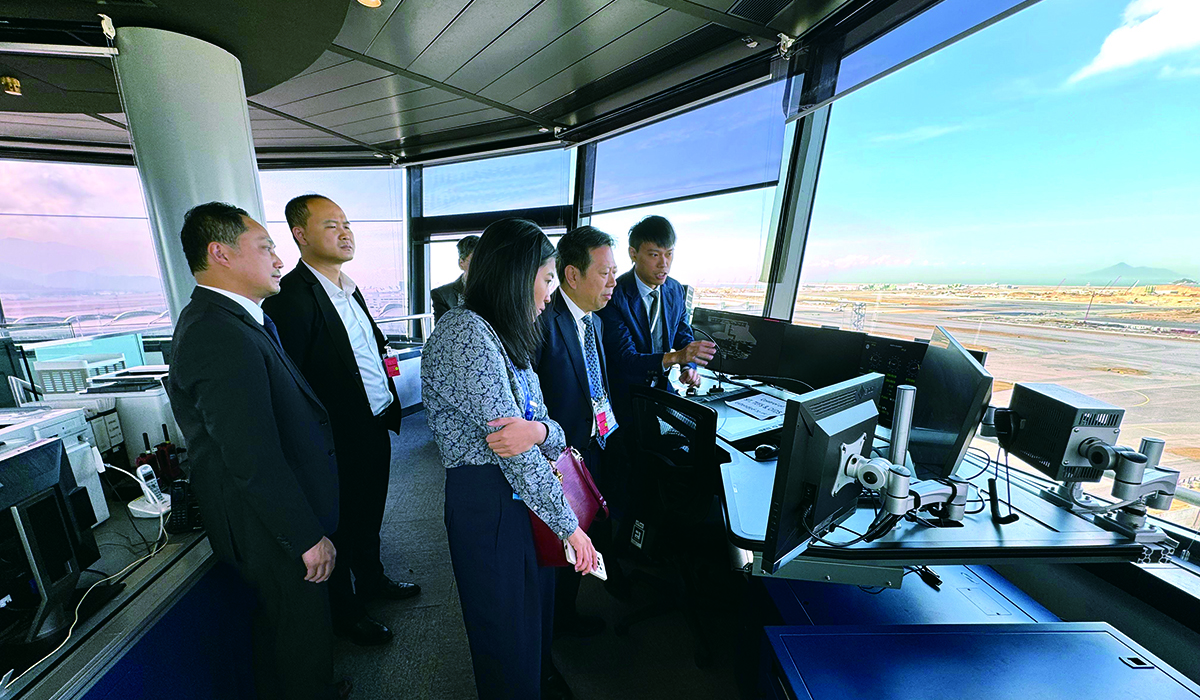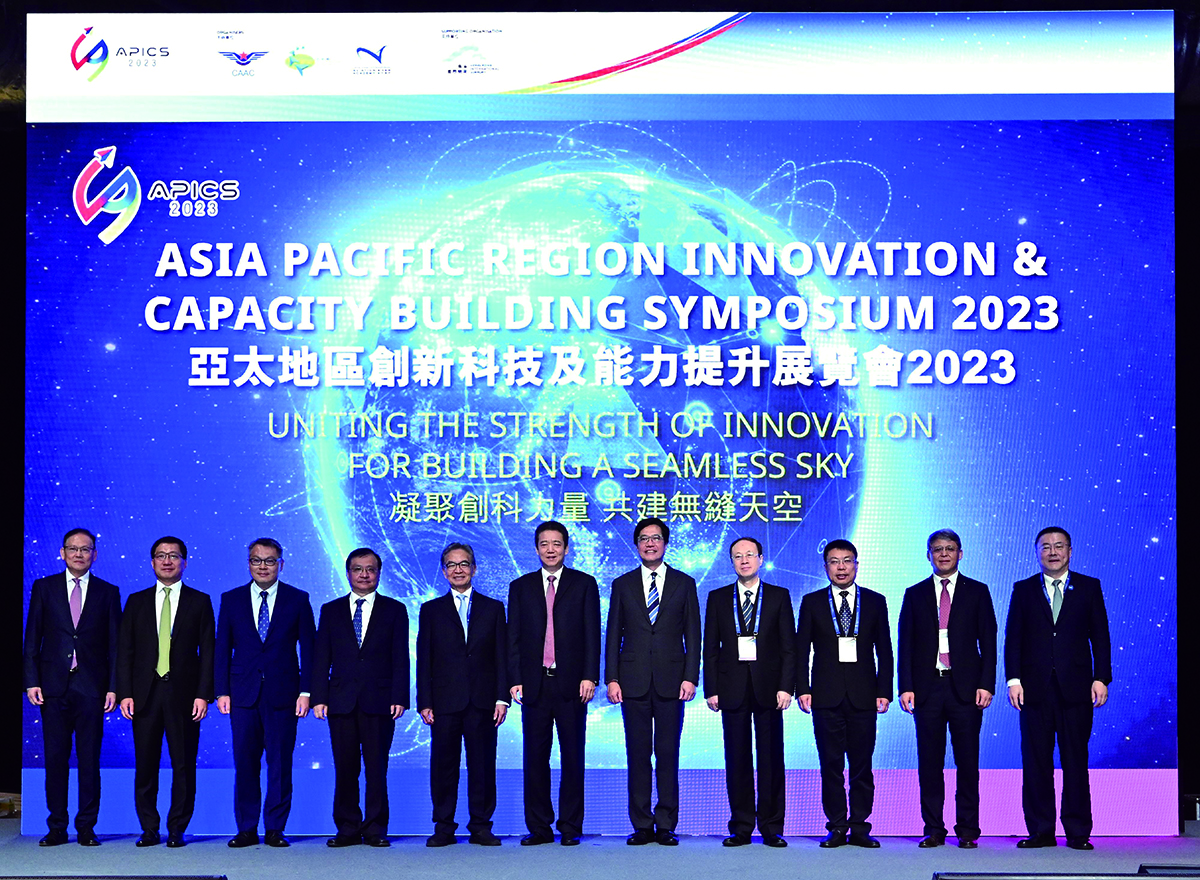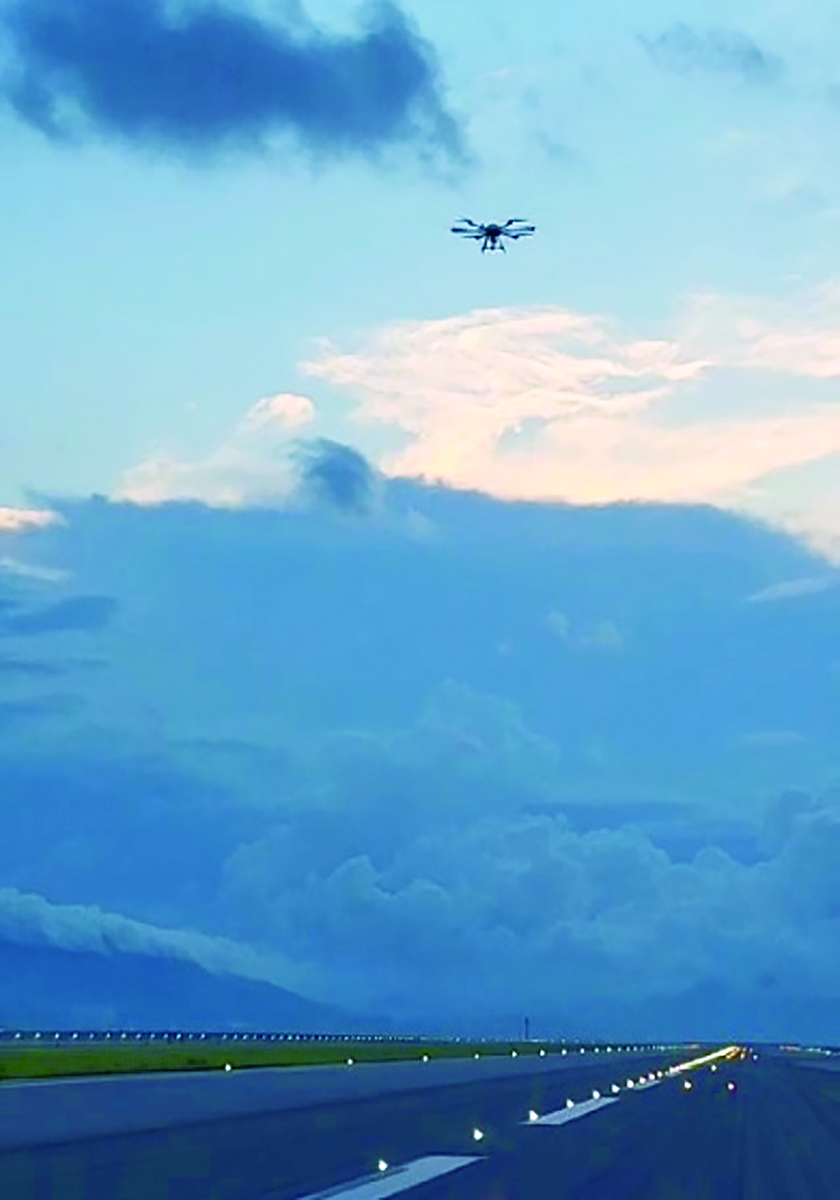The Air Traffic Engineering Services Division (AESD) is responsible for the design, planning, coordination, provision, commissioning, enhancement and maintenance of air traffic control (ATC) systems as well as communications, navigation and surveillance (CNS) facilities.
Smooth and Reliable Operation of ATC Systems
The ATC systems of the CAD have been operating smoothly and reliably round-the-clock to support air traffic services for aircraft flying within the Hong Kong Flight Information Region (HKFIR). A technical team comprising CAD electronics engineers, system contractors and maintenance service providers (MSPs) continued to oversee the operation and maintenance of the on-airport ATC systems, off-airport CNS systems and supporting infrastructure to provide smooth and reliable air navigation services for aircraft operating within the HKFIR.
In September 2023, Hong Kong was hit by a super typhoon and once-in-500-year heavy rainstorms. Thanks to the high resilience, robustness and comprehensive maintenance in CAD's critical aeronautical infrastructure (CAI), as well as the dedication of CAD and MSP colleagues who adhered to their duties and followed established procedures to swiftly handle the situation as the weather worsened, the CAI had weathered the storms with nil impact on provision of air navigation services.
The CAD will continue to ensure the smooth and reliable operation of its ATC systems, equipment and infrastructure and its readiness at all times to maintain Hong Kong's position as an international aviation hub.
Experience Sharing with Overseas Civil Aviation Authorities (CAAs) and Air Navigation Service Providers (ANSPs)
During the year, overseas CAAs/ANSPs and AESD continued to proactively arrange visits to each other to exchange views in air navigation service (ANS) technology innovation.
(i) Visit by ANSP of Thailand to CAD in June 2023
The delegation from the ANSP of Thailand (Aeronautical Radio of Thailand Limited - AEROTHAI) visited the CAD in June 2023 and exchanged views with CAD representatives to foster the civil aviation cooperation.
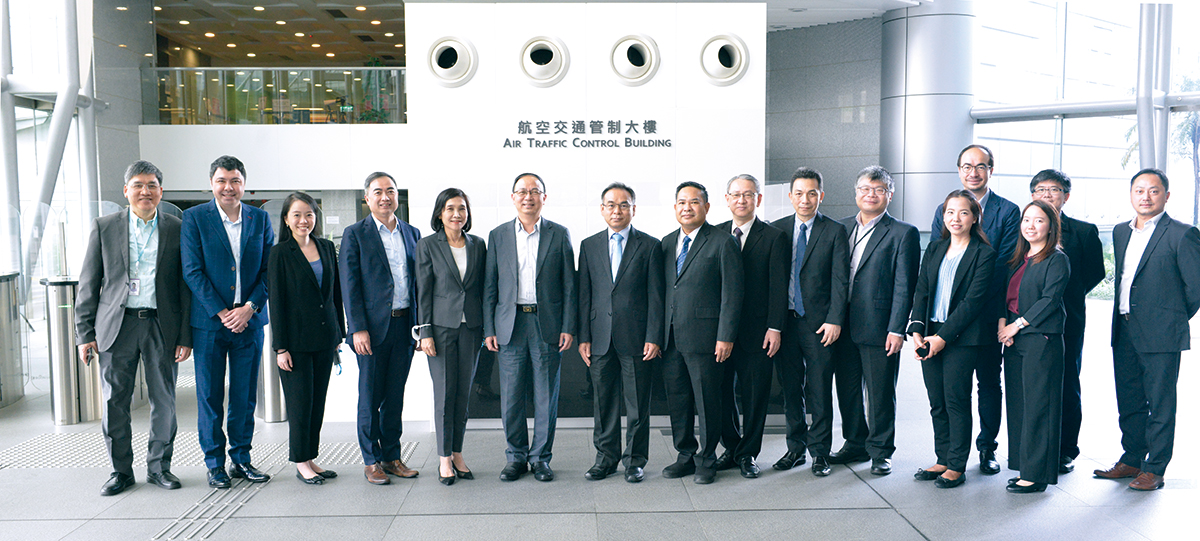
The Executive Vice President of AEROTHAI, Mr Paisan Praneetpongrang (seventh left), and his delegation visited the CAD.
(ii) Technical Visit to Civil Aviation Authority of Macao (AACM) and Macau International Airport Company Limited (CAM) in November 2023
The then Deputy Director-General of Civil Aviation, Mr Richard Wu, led a team consisting of electronics engineers and ATC operational personnel on a visit to AACM and CAM in November 2023, which enhanced collaboration and steered various matters of mutual interest.
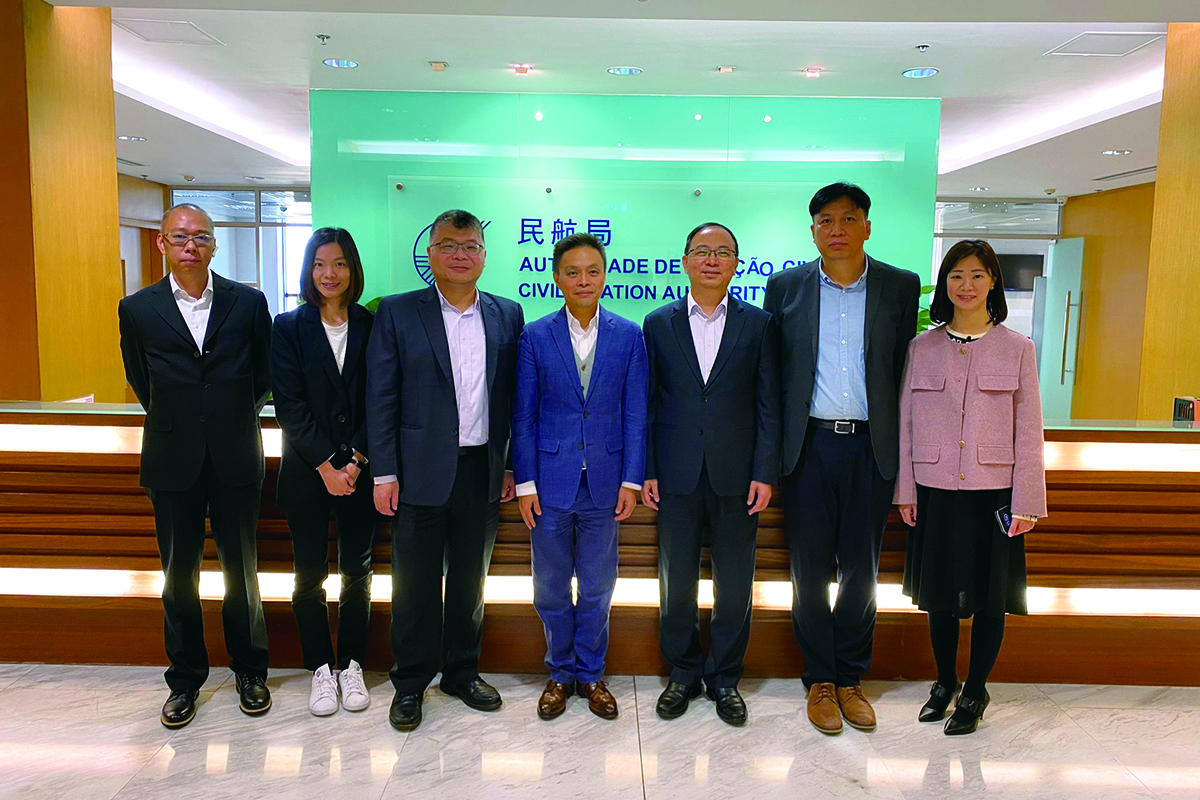
The then Deputy Director-General of Civil Aviation, Mr Richard Wu (third right), led CAD representatives in a technical meeting with AACM.
(iii) Visit by Civil Aviation Authority of New Zealand (CAANZ) to CAD in December 2023
The delegation from the CAANZ visited the CAD in December 2023 and exchanged views with CAD representatives on the application of Digital Tower technology in Hong Kong International Airport (HKIA) and the latest ANS innovation technology development.
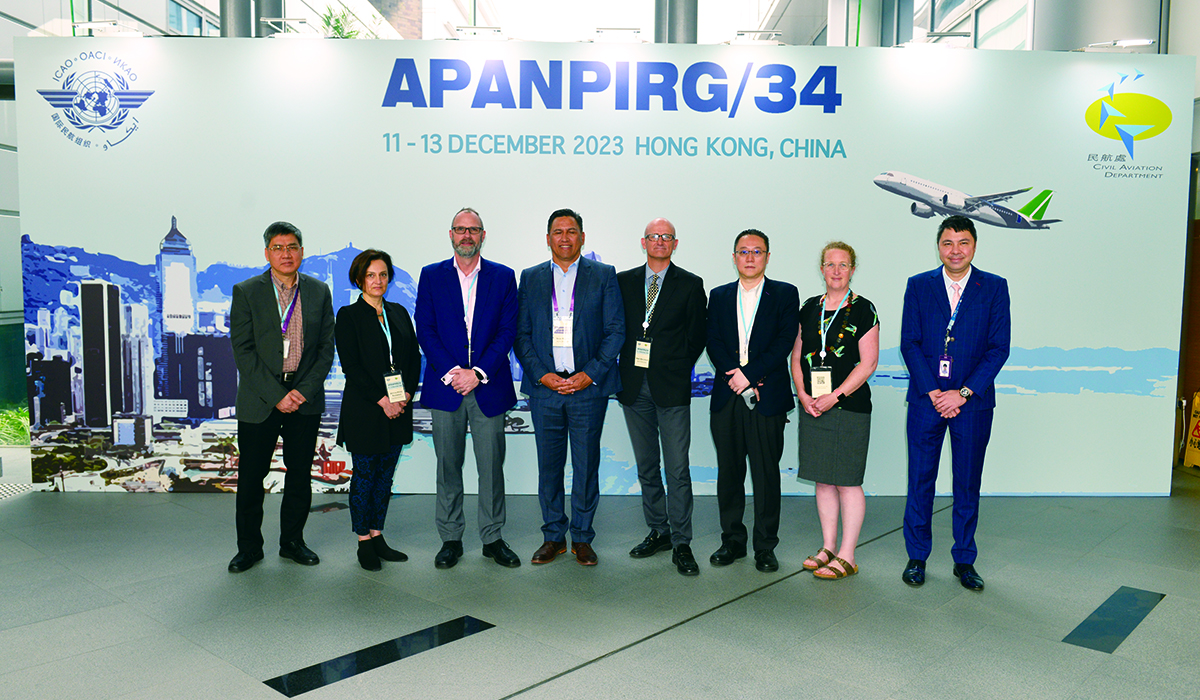
Manager, Aeronautical Services of the CAANZ, Mr Sean Rogers (fourth left), and his delegation visited the CAD.
(iv) Visit by Air Traffic Management Bureau (ATMB) of Civil Aviation Administration of China (CAAC) to CAD in December 2023
Led by Mr Li Qiguo, the Deputy Director-General of the ATMB of the CAAC, the ATMB delegation visited the CAD in December 2023, providing a valuable platform for discussions on various topics of mutual interest. The visit not only facilitated the active exchange of the latest technical developments, experience and knowledge, but also strengthened the cooperative relationship between the CAD and the ATMB of the CAAC.
(v) Visit by Civil Aviation Authority of the Philippines (CAAP) to the HKIA in January 2024
A delegation from the CAAP visited the HKIA and exchanged views with CAD representatives in January 2024.
(vi) Visit to Groupe ADP in Paris, France, in March 2024
The Director-General of Civil Aviation, Mr Victor Liu, led a CAD delegation comprising electronics engineers and ATC operational personnel to visit the Headquarters of Groupe ADP at Paris Charles de Gaulle Airport and the Advanced Air Mobility (AAM) Sandbox at Pontoise Airfield in Paris, France. Both parties shared their latest developments, including the promotion of smart airport development and low-carbon transformation. The CAD delegation also learnt about the strategies and plans of Groupe ADP in facilitating the trials of AAM.
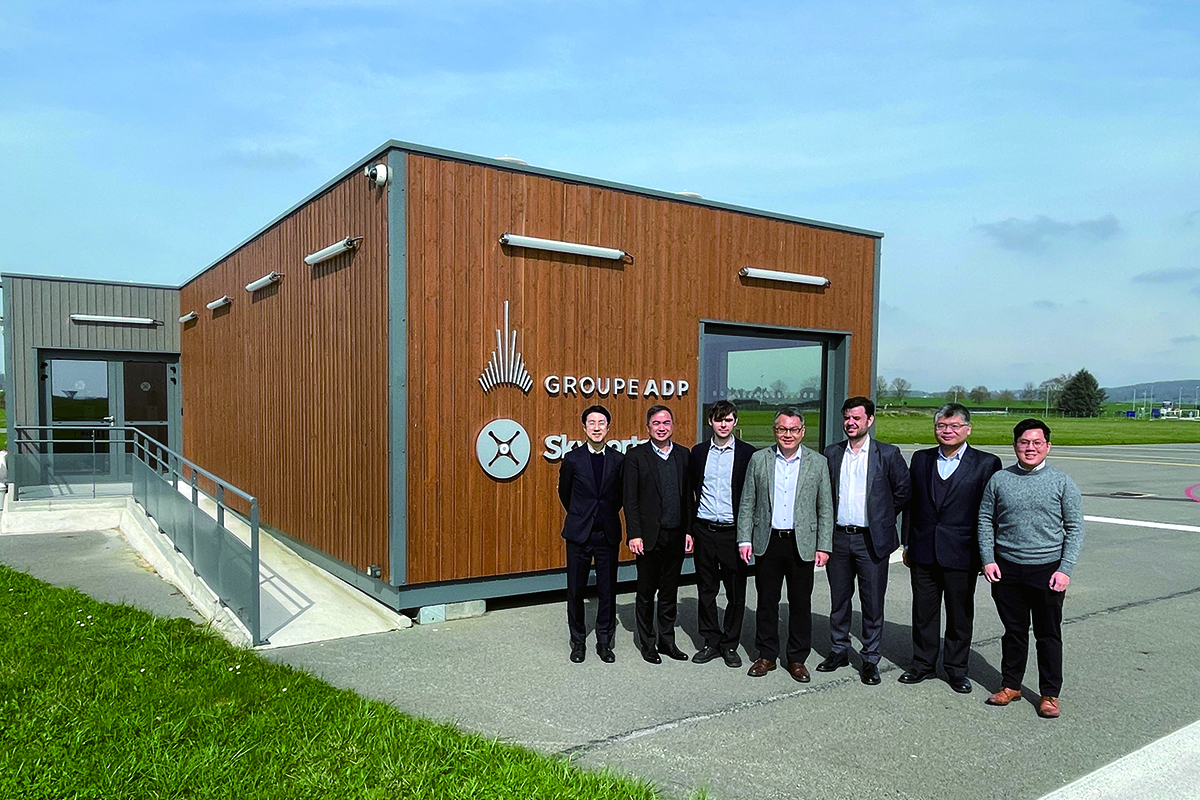
The Director-General of Civil Aviation, Mr Victor Liu (centre), led a CAD delegation to visit the AAM Sandbox at Pontoise Airfield in Paris, France.
(vii) 27th Meeting of the Communications, Navigation and Surveillance Sub-group (CNS SG) of the International Civil Aviation Organization (ICAO) Asia/Pacific Air Navigation Planning and Implementation Regional Group (APANPIRG)
The then Deputy Director-General of Civil Aviation, Mr Richard Wu, chaired the 27th Meeting of the CNS SG of ICAO APANPIRG as chairperson in ICAO APAC Regional Office, Bangkok, Thailand, from 28 August to 1 September 2023. The CNS SG plays an important role in facilitating the provision of seamless ANSs in Member States through coordinated deployment of advanced CNS technologies in a harmonised manner. The CNS SG steers to shape the future direction of CNS development. The meeting reviewed achievements and tasks of the Sub-group since its previous meeting and the outcomes of other contributory bodies under the CNS SG. The CAD delegation comprising electronics engineers and ATC operational personnel shared at the meeting the experiences in in-situ replacement of Instrument Landing System (ILS) at the HKIA, high resilience in maintaining reliable operations of CAI, trials in the use of drone to enhance efficiency in flight inspections at the HKIA, and encouraged States/Administrations and regions to support and participate in the inaugural Asia Pacific Region Innovation & Capacity Building Symposium 2023 (APICS 2023) in December 2023.
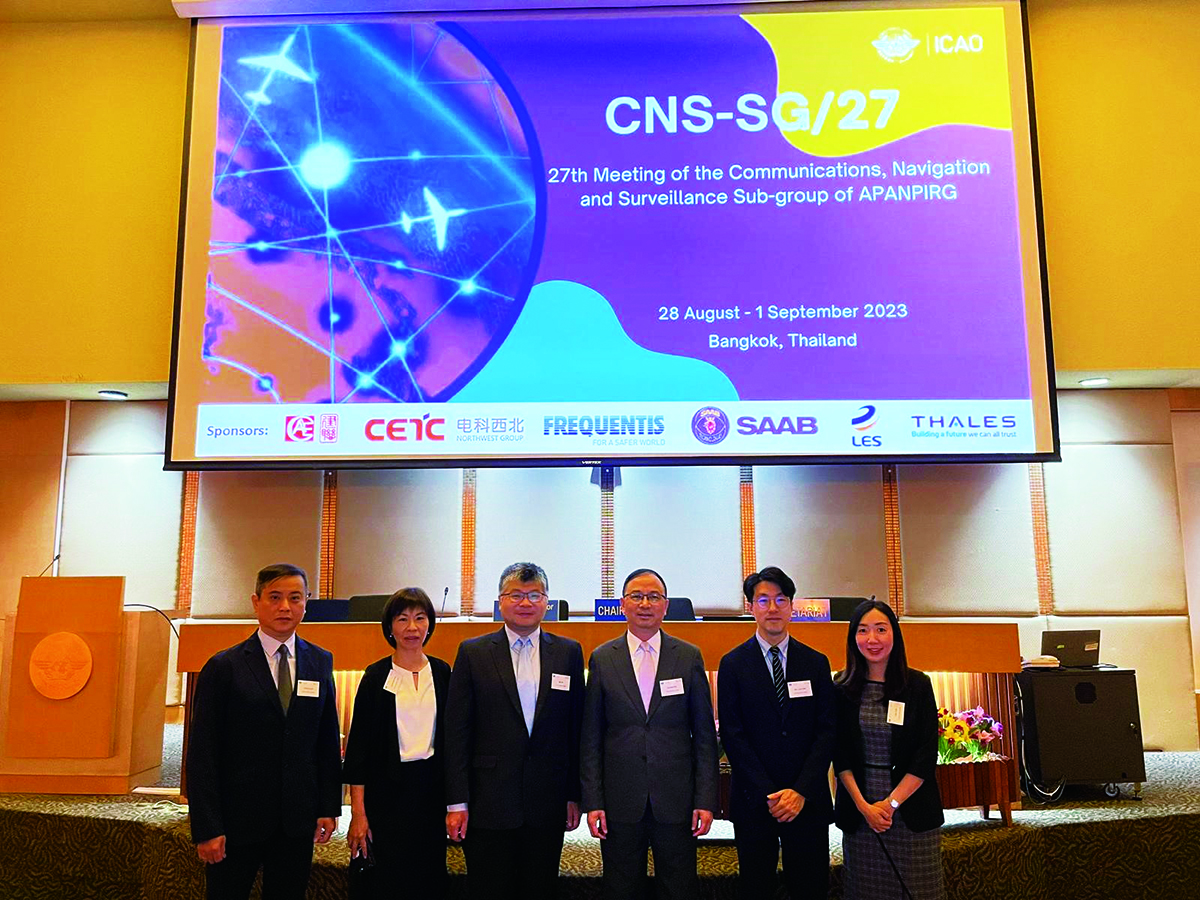
The then Deputy Director-General of Civil Aviation, Mr Richard Wu (third right), chaired the 27th meeting of the CNS SG of ICAO APANPIRG.
(viii) Hosting of the inaugural APICS 2023 at AsiaWorld-Expo
The APICS 2023, jointly organised by the CAAC, the Hong Kong CAD and the Hong Kong International Aviation Academy, with support from the ICAO Asia and Pacific Regional Office and the Airport Authority Hong Kong (AAHK) took place on 14 and 15 December 2023 at the AsiaWorld-Expo.
The two-day symposium was a signature event attended by over 2 000 aviation professionals from around the world, including top leaders and experts from civil aviation authorities, ANSPs, airport operators and aviation industry as well as young talent from around 40 States/Administrations and regions. The event successfully facilitated discussions on innovative technologies and capacity building in both regional and international contexts and provided an excellent platform for participants to establish network and foster collaboration.
Visit to the Civil Air Navigation Services Organisation (CANSO) Airspace World 2024
The Director-General of Civil Aviation, Mr Victor Liu, led a delegation comprising electronics engineers and ATC operational personnel to attend the CANSO Executive Summit and Airspace World 2024 in Geneva, Switzerland in March 2024 to gain insight into the latest development and innovative technologies of the industry and stay connected with leading ANSPs and systems integrators.
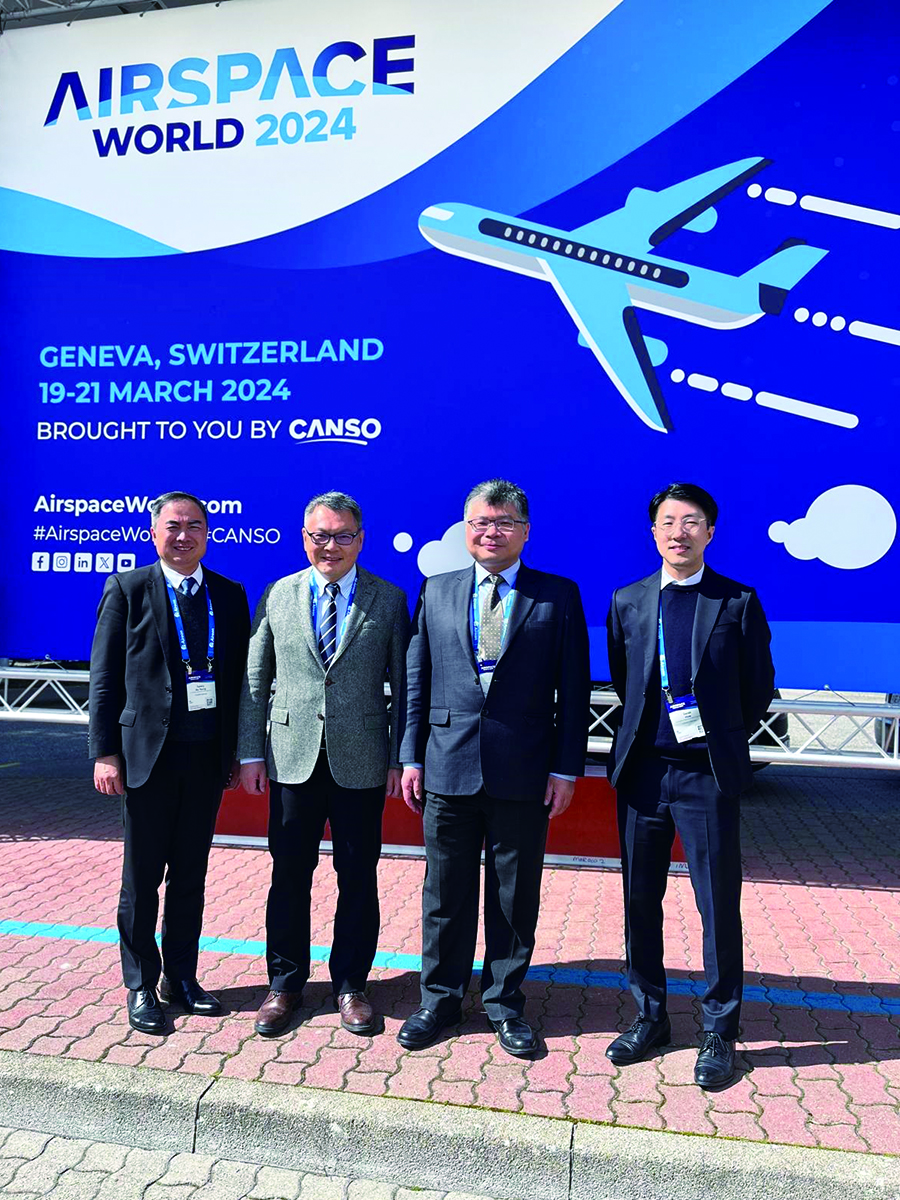
The Director-General of Civil Aviation, Mr Victor Liu (second left), led a delegation to participate in the CANSO Airspace World 2024.
Aviation System Block Upgrades (ASBU)
In accordance with the ICAO's ASBU framework and the priorities stipulated in the Global Air Navigation Plan (GANP) and Seamless ANS Plan for the APAC region, the CAD continued to collaborate with stakeholders in the aviation industry to develop strategies for the phased implementation of the ASBU modules in Hong Kong through the ASBU Planning and Implementation Committee, as well as review the latest implementation status and steer relevant planning and implementation in Hong Kong.
(i) Support for ICAO ASBU Panel Project Team
The CAD joined the Chinese delegation in participating in the ICAO ASBU Panel Project Team. This engagement aims to learn from and contribute to the latest developments in ASBU, thereby keeping Hong Kong at the forefront of ASBU implementation.
(ii) Support for ICAO Workshop on APAC Regional Seamless ANS Plan Reporting Tool
For reporting on the latest implementation status of the Seamless ANS Plan to the ICAO APAC Regional Office, the CAD provides substantial support to the ICAO APAC Regional Office on the implementation of the APAC Regional Seamless ANS Plan Reporting Tool, which was introduced and demonstrated during the Thirty-fourth Meeting of the APANPIRG held in December 2023 in Hong Kong, China. The CAD played a pivotal role in preparing and conducting an ICAO workshop on the APAC Regional Seamless ANS Reporting Tool to share our experience in using the tool with the participants.
(iii) Support for ICAO Frequency Spectrum Management Panel
Radio frequency plays a crucial role in the civil aviation industry supporting operations of various CNS systems. These systems require protected radio frequencies for their smooth and reliable operations.
The ICAO Frequency Spectrum Management Panel advises the Air Navigation Commission on all matters relating to frequency spectrum for the CNS services.
The Panel develops the ICAO Position and other supporting materials to facilitate updates to the International Tele-communication Union (ITU) Radio Regulations, which are regularly reviewed by ITU-World Radiocommunication Conference. The CAD has been invited by CAAC as a technical advisor to provide support for their work under the Panel. The CAD collaborates with other stakeholders during the panel meeting and other events to develop strategies for optimising the radio spectrum for aeronautical use.
Safety Management System (SMS)
The AESD values the importance of safety in the provision of air navigation service. The safety performance of Maintenance Service Providers was reviewed and monitored through regular SMS Review Meetings, including the safety trend, safety performance indicators and safety performance targets for the CNS/Air Traffic Management System (ATMS) equipment, to ensure that the established safety management actions and procedures were implemented as planned, and that all safety targets were met. Besides, the AESD continued to upkeep its good safety performance by conducting regular safety audits, workshops and training to support the operation and maintenance of various systems and project works.
During the year, five SMS trainings/briefing and three safety audits were conducted. The basic SMS training for the AESD new comers was conducted in November 2023. Safety audits on safety performance of cyber security, project management and systems maintenance were conducted in June and September 2023 and February 2024 respectively.
Cyber Security
Cyber security is one of the most critical matters in the global aviation industry. The ICAO has established the Cybersecurity Panel to support the implementation of related work. A cyber security expert of the AESD was appointed by the CAAC since 2022 to serve as a technical advisor in cyber security to support the CAAC's work in the ICAO Cybersecurity Panel, that plays an indispensable role in developing a range of aviation cybersecurity guidance materials for adoption and implementation by member states. This also benefits the AESD staff to contribute to the development of the country's civil aviation industry.
The CAD received the Bronze Award in "Government Departments & Public Bodies Sector" in "Cyber Security Professionals Awards 2023" held in February 2024 in recognition of CAD's professional contributions in cyber security.
At the same time, to cope with the ever-changing cyber security landscape, the CAD has conducted a series of activities to safeguard our ANS equipment and Information Technology (IT) systems against cyber threats, and to achieve a zero-incident cyber security record.
During the year, the AESD organised the first Attack-with-Defence exercise in collaboration with cybersecurity consultants and other CAD divisions. The AESD also worked with cyber security consultants to organise two interactive and practical Cyber Security Awareness Training Workshops in March 2024 to raise cybersecurity awareness among staff and contractors.
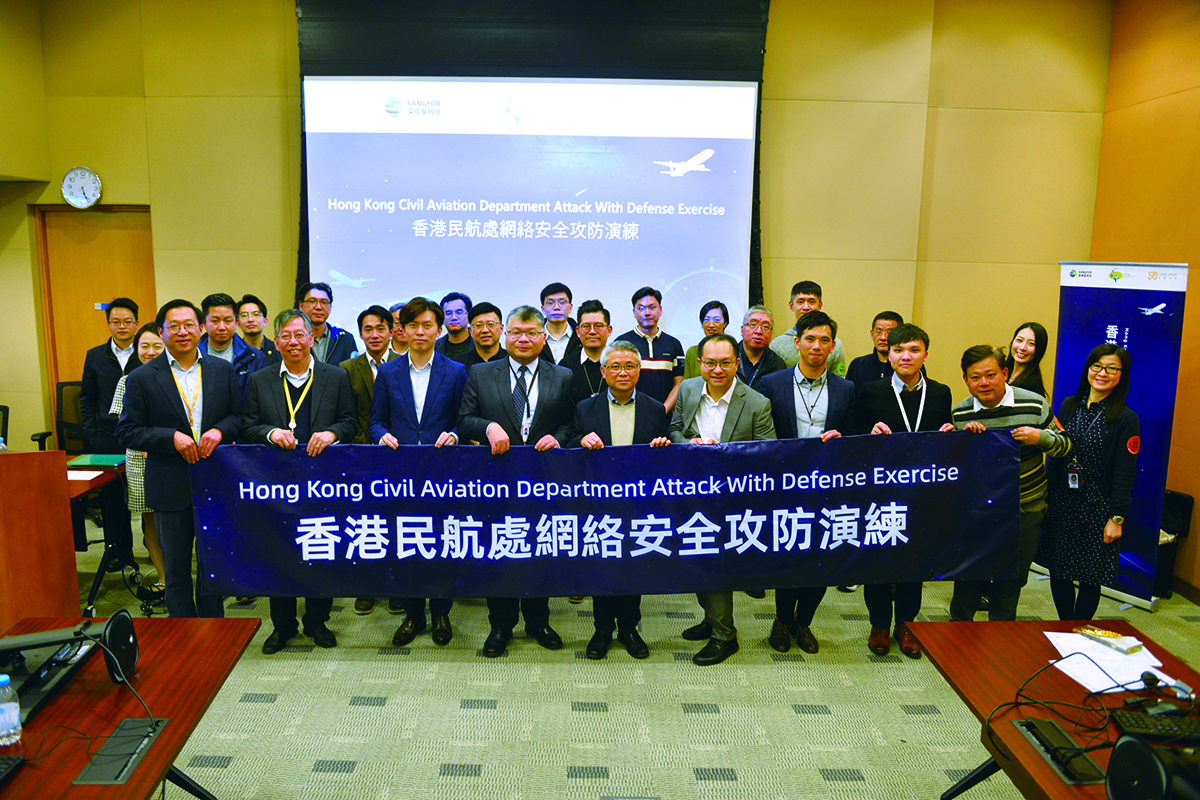
Participants of the Attack-with-Defence exercise were pictured in a group photo at the end of the exercise.
Flight Check
In accordance with the ICAO requirement, routine flight checks for navigational aids at the HKIA are conducted twice a year, which usually take place in May and November during non-peak traffic seasons. To start the flight check in early mornings before air traffic building up is crucial in minimising potential impact on both the HKIA and ATC operations.
In face of the challenge brought by the strong rebound in air traffic after the pandemic, the AESD successfully coordinated with various stakeholders including the Flight Inspection Center (FIC) of the CAAC, AAHK and Hong Kong Business Aviation Centre to conduct the routine flight check for the navigation aids at the HKIA in May and November 2023 with satisfactory results.
To enhance efficiency of flight checks, the AESD has also taken the initiative in exploring innovative means to test the feasibility of carrying out part of the flight check work by small unmanned aircraft (SUA). In August 2023, the first trial flight check by SUA was completed successfully with the support from the CAAC FIC as well as AAHK. The trial demonstrated that conducting part of the flight checks using SUA on the ILS and Airport Ground Lighting was more efficient in deployment, flexible in flight manipulation and environmentally friendly. Its inspection results are also in line with those obtained by traditional flight inspection aircraft.
New Technologies for Satellite-based CNS/ATM Systems
To comply with the roadmap in the ICAO's GANP, the CAD has formulated a plan to progressively trial and implement various new technologies for satellite based CNS/ATM Systems and services. The Pre-Departure Clearance Two way Datalink Service, Electronic Flight Strip System, Arrival Manager System and Air Traffic Services Inter-facility Data Communication have been integrated smoothly with the ATMS and working satisfactorily since its full commissioning. The latest development of other new technologies and systems is highlighted below:
(i) Advanced Surface Movement Guidance and Control System (A-SMGCS)
The phase one project of the A-SMGCS was completed and put into service to provide comprehensive surveillance and safety alert functions of aircraft and ground vehicle movements at the HKIA to support Interim Two-runway System (I-2RS) operations. The system is equipped with additional sensors to expand the surveillance coverage to the North Runway and associated taxiways. The phase two project is planned for commissioning in 2024 to support the Three-runway System (3RS) operations.
(ii) Surface Movement Radars (SMRs)
SMRs are positioned at the top of new tower structures in five locations of the HKIA for surveillance of aircraft and vehicles on the runways and taxiways. They provide surveillance information for the A-SMGCS to enable the air traffic controllers to maintain a smooth ground traffic during all weather conditions.
(iii) Space-based Automatic Dependent Surveillance-Broadcast (ADS-B) Data
With the commissioning of terrestrial-based ADS-B system, the safety and operational efficiency of the ATC services have been enhanced. In addition, the use of Space-based ADS-B data in ATC systems continued to boost the department's long-ranged surveillance capability and facilitated provision of air traffic flow management (ATFM) service.
(iv) Ground Based Augmentation System (GBAS)
The GBAS makes use of the Global Navigation Satellite System for supporting satellite-based precision approach and landing of aircraft. The system provides approach path data, corrections and integrity information to equipped aircraft landing at the airport. The CAD has been actively participating in the ICAO APAC GBAS/Spaced Space Augmentation System Implementation Task Force meetings and International GBAS Working Group meetings to share our experience at the HKIA and keep abreast of the latest development of the GBAS technology in order to prepare for future GBAS deployment at the HKIA.
(v) Instrument Landing System (ILS)
The ILS consists of a 32-element ultra-wide aperture Localiser antenna array, M-Type 3-element Glide Path antenna system and bi-directional Distance Measurement Equipment. The replacement of the legacy ILS at each end of the South Runway was carried out in an in-situ manner and completed successfully without affecting operation of the South Runway in November 2023. For the ILS at each end of the Centre Runway, installation has been completed and is planned for commissioning upon completion of flight check in 2024.
(vi) Airport Collaborative Decision Making (A-CDM)
The AESD completed the enhancement of A-CDM Gateway to support provision of more comprehensive air traffic data to the AAHK, so as to facilitate the CAD and AAHK to more efficiently cope with challenges arising from the 3RS operation. As always, the CAD continues to fully support and provide advice on technical and operation aspects for enhancing HKIA's overall operational efficiency. To assist the steering of regional A-CDM development, the CAD kept taking an active role in the relevant ICAO Regional Task Force meetings to share our experience at the HKIA and to advocate the development of the regional roadmap. The CAD will continue to proactively participate in and promote the interoperability on A-CDM and ATFM for the region.
(vii) Digital Tower Facilities (DTF)
The DTF is equipped with ultra-high resolution surveillance cameras to provide real-time digitised panoramic views of the airport. With adoption of digitised video analytics, movements of aircraft and ground vehicles are tracked in real-time manner and displayed with corresponding flight information tags. Use of artificial intelligence (AI) technology provides additional safety alert functions, such as early detection of conflicting situation or intrusion into airfield restricted areas. Phase one of the DTF was officially commissioned to enhance the overall efficiency and situation awareness of air traffic controllers. Phase two of the DTF is underway with the target for commissioning in 2024 to support the 3RS operations.
The CAD and AAHK jointly implemented the Digital Apron and Tower Management System (DATMS) at the HKIA. The DATMS won the 2023 Technology Innovation Awards of the Airports Council International for "Best Innovation in Airport Operations and Installations Management", commending the joint efforts of the CAD and AAHK in implementing innovative technologies for enhancing safety and operational efficiency at the HKIA.
(viii) Control Tower Simulator (CTS)
To enhance training for tower controllers for efficient rolling out of the I-2RS and 3RS operations, the AESD, in joint efforts with the Air Traffic Management Division, installed a CTS at the CAD Headquarters and upgraded the existing CTS. The CTS, equipped with state-of-the-art projection and image generation technologies, is one of the most advanced CTS deployments worldwide. During the year, the AESD continued to update the CTS database to simulate the latest physical environment of the HKIA to provide the best training facilities for tower controllers.
(ix) Asia Pacific Common Regional Virtual Private Network (CRV)
The ICAO has formulated an action for its member states to expedite the CRV implementation for the region pursuant to their cost benefit analysis. In support of this initiative, the CAD has commenced the migration of its existing circuits to the CRV progressively with a view to improving efficiency in aeronautical communication with other Area Control Centres (ACCs). The migration to CRV of voice or data communications with Manila, Fukuoka, Beijing and Bangkok ACCs has been completed by the CAD. The migration to CRV for Ho Chi Minh City and Macao is targeted for completion in 2025.
(x) Approach Spacing Management System (ASMS)
The ASMS at the Air Traffic Control Centre has been implemented for enhancing the operational efficiency in handling aircraft's final approach operation under enhanced wake turbulence separation scheme and for improving consistency in delivering arrival traffic spacing. With the completion of system acceptance testing, flight check and relevant safety assessment and trial operation, the ASMS has been put into operation since March 2024.
The ASMS implementation has led to substantial benefits, including reduced airborne delays, increased runway capacity and fuel savings with reduction in CO2 emissions from aircraft. The implementation received the runner-up honours in the "Greener Skies" category of the Air Traffic Management Awards 2023 presented by the CANSO. This award recognises the achievements of CAD in utilising advanced technologies to promote sustainable and environmentally friendly air navigation services.
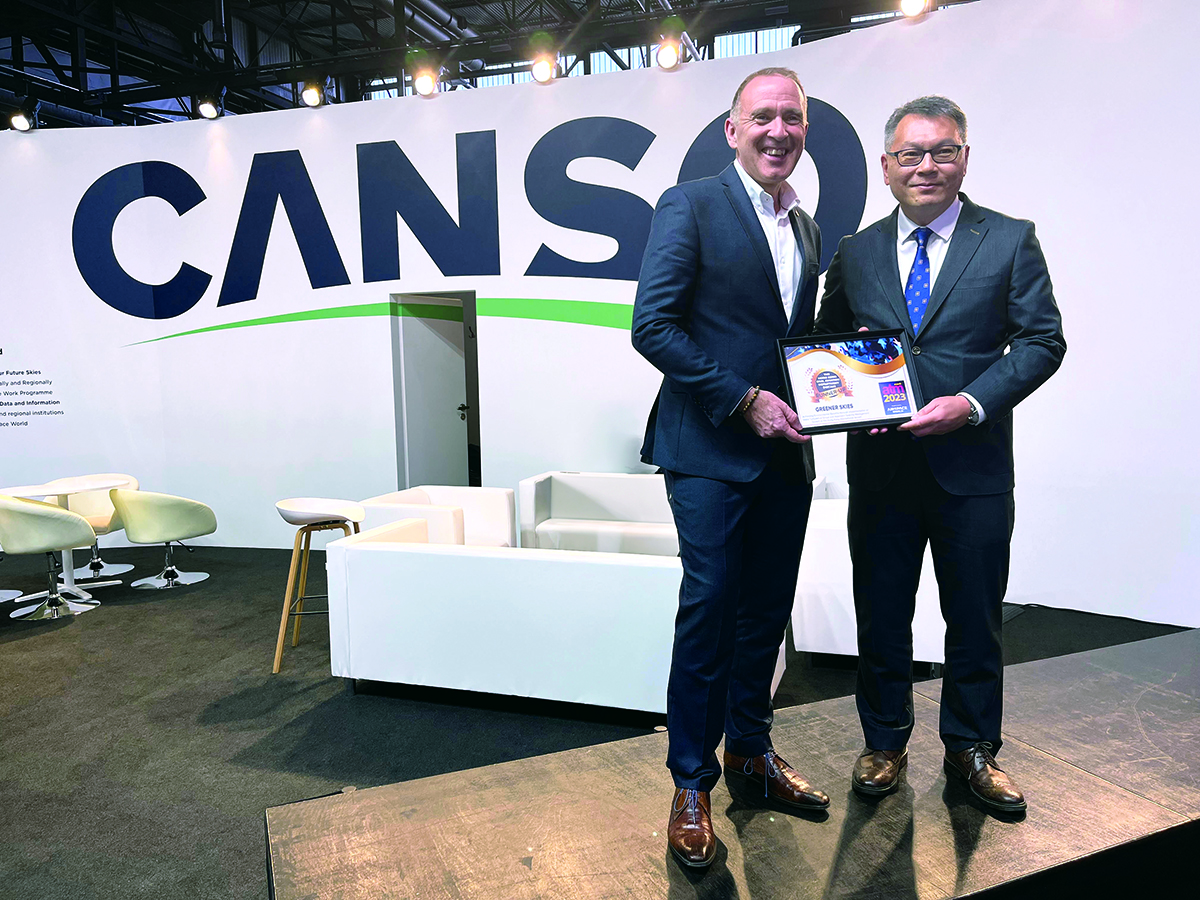
The Director-General of Civil Aviation, Mr Victor Liu (right), received the runner-up award in the "Greener Skies" category of the Air Traffic Management Awards.
System Wide Information Management (SWIM)
SWIM is an integral part of ICAO GANP and covers a number of the ASBU modules derived from the GANP. It aims to promote the exchange of aviation information (flight, meteorological and aeronautical) on a standardised and common platform among aviation stakeholders.
(i) Participation in SWIM Operational Trial on ATFM
The CAD always supports the ICAO in the promotion and implementation of SWIM in the APAC region. In January 2024, the CAD along with other pioneering ANSPs, completed the SWIM-based ATFM operational trial to perform the ATFM operation through real-time exchange of SWIM information, to showcase the benefits of SWIM.
(ii) Promoting Regional Sharing of Aeronautical Surveillance Data through SWIM
The CAD has been steering collaboration amongst pioneering ANSPs and industry partners in the region to jointly promote the sharing of aeronautical surveillance data under the SWIM environment with a view to enhancing the ATC safety and operational efficiency. In 2023, the AESD has led a dedicated ICAO APAC study group to prepare a proof-of-concept test and trials scheduled for May 2024 to serve as a reference model for future SWIM implementation.
Smart Energy Savings at CAD Headquarters
During the year, the AESD continued to explore and implement projects and measures to save energy and reduce carbon emission in collaboration with other CAD divisions, such as switching to more energy-efficient lighting with occupancy sensors, water pumps and air conditioning units, etc. Administrative measures such as green awareness promotion, optimisation of operating hours of lighting, air conditioning and temperature settings, lifts/escalators, etc. were also adopted. For renewable energy projects, solar panels were deployed at CAD outstations. The CAD continued to actively explore new energy-saving applications and innovative technology such as High-Volume Low-Speed ceiling fan and immersion cooling technology for direct cooling of computer equipment.
The CAD actively participated in activities and events to share our experience in applying advanced technology to achieve energy savings. The application of AI technology to the Energy Optimisation System of the chiller plants at CAD headquarters had further achieved energy saving, for which CAD was recognized by professional bodies through awards, including the "Best Digital Innovation Award - Merit" by Chartered Institution of Building Services Engineers Hong Kong, the R&D award of the "Excellent Intelligent Green Building Systems and Projects Award 2023" by Asia Institute of Intelligent Buildings as well as the "Innovation Excellence Award (Corporate and Government Bodies) of the Smart Energy Award 2023" by CLP Light Power Hong Kong Ltd.
Refurbishment of East Air Traffic Control Centre (E-ATCC) Expansion Area
The refurbishment works of the existing E-ATCC expansion area was in smooth progress and was targeted for completion in 2024. Upon completion of the refurbishment works, the CAD would set up new controller working positions and a new ATFM Centre in the expansion area to cope with the increasing air traffic after the commissioning of the 3RS.
Refurbishment of Off-airport Outstations
The CAD commenced refurbishment works for the building and facilities of off-airport outstations in phases to match with the replacement plans of various ANS equipment. The CAD engaged architectural and quantity surveying consultants through open tender to provide the detailed design and quantity surveying services for various refurbishment works. The contract for the first phase of the refurbishment works of off-airport outstations was awarded in November 2023 and the refurbishment works commenced in December 2023. In the meantime, the detailed design and tender preparation works for the second phase of the refurbishment works have come to the final stage and would put up for tender in May 2024.
Information Technology Management
The Information Technology Management Unit (ITMU) has carried on supporting the day-to-day operations of various CAD divisions through effective implementation of new Information Technology initiatives, e-Government strategy and upgrade of IT equipment and network infrastructure.
Apart from day-to-day IT support for CAD officers and maintenance of IT systems and infrastructures, the ITMU has been assisting the department in setting up the Electronic Recordkeeping System to gradually replace the conventional paper-based filing system. First phase for the implementation was completed in March 2024.
The CAD has launched an electronic portal for SUA for members of the public to register their SUA and obtain safety information for complying with the relevant legislation. Software upgrade for enhancing system features and efficiency of daily system administration was also implemented.
ITMU diligently prepared for the launch of the new Personnel Licensing Information System (PLIS) in March 2024. Key activities included system design, infrastructure setup, cyber security assessment, load and stress testing, data migration, and rigorous testing in collaboration with internal offices. The ITMU worked closely with relevant stakeholders to ensure a seamless transition from the legacy system to the new PLIS.
Additionally, user training sessions were conducted to familiarise both internal users and external parties, such as airlines and medical examiners, with the enhanced features and functionalities of the new system. As a result of these collaborative efforts of all stakeholders, the PLIS was successfully deployed, enhancing licensing processes and improving overall efficiency.
Dashboards running on the CAD Big Data Analytics Platform were also developed by the ITMU to facilitate air traffic management professionals in analysing the flight trajectories of aircraft for optimising the operational efficiency and safety of ATC.


